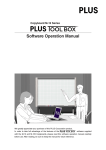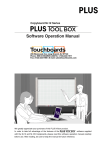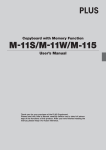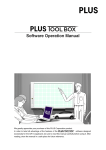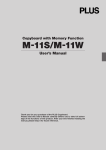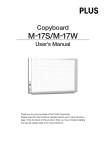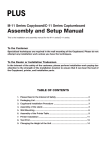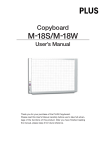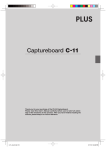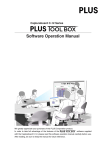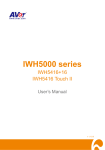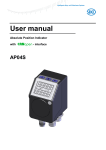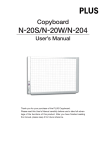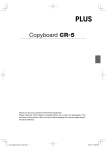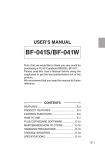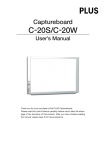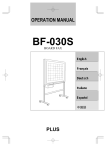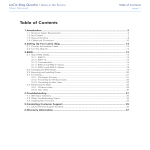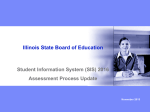Download M-12S/M-12W/M-125
Transcript
Copyboard
M-12S/M-12W/M-125
User’s Manual
Thank you for your purchase of the PLUS Copyboard.
Please read this User’s Manual carefully before use to take full advantage of the functions of this product. After you have finished reading
the manual, please keep it for future reference.
The descriptions in this manual are for the M-12S, M-12W and M-125.
There are three types of copyboards: the 2-page standard size type (model M-12S), the 2-page wide size
type (M-12W) and the 4-page + screen type (M-125).
In addition, depending on the product you have purchased, the printer and stand may be sold separately.
The descriptions and diagrams in this manual refer to the model M-12S.
* When functions or operations are specific to a certain model of copyboard, the model name is specified.
Trademarks
• Microsoft and Windows are registered trademarks or trademarks in the United States and other countries of the Microsoft
Corporation.
• Adobe and Adobe Acrobat Reader are trademarks of Adobe Systems Incorporated.
• Velcro is a registered trademark of Velcro Industries.
The trademarks of the various companies and the product trademarks, even when not written down, will be given due
respect.
Product names and company names appearing in this manual are registered trademarks or trademarks of the respective
companies.
(1)
(2)
(3)
(4)
(5)
(6)
The contents of this manual may not be reprinted in part or whole without permission.
The contents of this manual are subject to change without notice.
Great care has been taken in the creation of this manual; however, should any questionable points, errors, or omissions
be apparent, please contact us.
Notwithstanding Section (3), this company will not be responsible for any claims of loss or profit or other matters
deemed to be the result of using this unit.
The use of a printer as the peripheral device of the PLUS Copyboard is taken to be a prerequisite; therefore, operation
will not be guaranteed when the printer is used with a direct connection to a personal computer.
Manuals with incorrect collating or missing pages will be replaced.
E-2
Table of Contents
Important Safety Information .........................................................................................................E-4
Package Contents ...........................................................................................................................E-7
Main Functions ................................................................................................................................E-8
Names of the Parts..........................................................................................................................E-9
Front ............................................................................................................................................ E-9
Rear ............................................................................................................................................ E-10
Changing the Height of the Unit ................................................................................................... E-11
Control Panel (models M-12S and M-12W) ................................................................................. E-12
Control Panel (model M-125) ....................................................................................................... E-13
Operation Steps .............................................................................................................................E-14
Connecting the Power ..................................................................................................................E-15
Setting the Time ............................................................................................................................E-16
Printing ...........................................................................................................................................E-18
Preparing the Printer .................................................................................................................... E-18
Basic Printing Operation ............................................................................................................. E-19
Selecting the printing density .................................................................................................. E-21
Making additional copies ....................................................................................................... E-21
Cancellation of the print operation in progress ....................................................................... E-21
Specifying the Page (model M-125) ........................................................................................ E-22
Switching to the screen (model M-125) .................................................................................. E-22
Printing in the same ratio as the sheet surface (Model M-12W) ............................................... E-23
Moving the sheet surface manually ........................................................................................ E-23
Using USB Memory .......................................................................................................................E-24
USB Memory Storage Procedure ................................................................................................ E-24
Saving Image Files on a Computer/Deleting Image Files .............................................................. E-27
Making the Function Settings ......................................................................................................E-29
Basic Setting Operations ............................................................................................................. E-29
Table of Function Numbers, Selected Modes and Lamp Statuses ............................................... E-30
Accompanying Software...............................................................................................................E-31
Software Contents and Overview................................................................................................. E-31
Operating Environment ................................................................................................................ E-32
Dedicated software's setting items and factory defaults............................................................... E-32
Meaning of Error Messages .........................................................................................................E-33
Troubleshooting .............................................................................................................................E-34
Specifications ................................................................................................................................E-36
Appendix ........................................................................................................................................E-37
Connections and Wiring Diagram ................................................................................................ E-37
Meaning of the Terms Used in this Manual
• USB memory: refers to USB flash memory.
• USB memory storage: means the saving of sheet surface data using MEMORY (i.e., the USB port) of the
operation panel. (The Copyboard has 3 USB ports.)
• Internal memory: indicates a temporary saving location of the image that has been read.
• “copy”: Both “print” and “USB memory saving” mean to “copy.”
• Page (model M-125): The number assigned to the sheet surface is called the “page”.
• Screen (model M-125): The “S” page for projecting images of optical devices is called the “screen”.
• “Sheet surface”: refer to the drawing portion.
• “Scroll” or “move”: indicates feeding of the sheet.
E-3
Important Safety Information
WARNING
WARNING
The unit’s rear panel should never be opened
by anyone other than a qualified serviceperson.
Contact your store of purchase to request internal inspection, adjustment, repair, and cleaning.
This product is not for use in Computer Rooms.
The description “Computer Rooms” refers to
areas where an abundance of computer control equipment (such as high output servers) is
being used.
It does NOT refer to environments such as
offices or classrooms where there are simply
PC’s being used.
CAUTION
Continued use of the unit under abnormal
conditions (when the unit is emitting smoke,
unusual odors or sounds) could lead to fire or
electric shocks.
Turn off the unit’s power immediately, then
unplug the AC power adapter from the power
outlet.
Check that no more smoke, etc., is being emitted, then contact a sales outlet for repairs.
Repairing the unit yourself is dangerous. Never
attempt to do so.
This symbol warns the user that uninsulated
voltage within the unit may have sufficient magnitude to cause electric shock. Therefore, it is
dangerous to make any kind of contact with any
part inside of this unit.
This symbol alerts the user that important literature concerning the operation and maintenance of this unit has been included. Therefore,
it should be read carefully in order to avoid any
problems.
WARNING
This is a class A product. In a domestic environment this product may cause radio interference in which case the user may be required to
take adequate measures.
SAFETY PRECAUTIONS
Heeding the safety precautions below will lengthen the
product’s service life and prevent fires, electric shocks and
injury. Read these safety precautions carefully and be sure
to heed them.
WARNING
The Federal Communications Commission
does not allow any modifications or changes
to the unit EXCEPT those specified by PLUS
Vision Corp. in this manual. Failure to comply
with this government regulation could void your
right to operate this equipment.
This equipment has been tested and found
to comply with the limits for a Class A digital
device, pursuant to
Part 15 of the FCC Rules. These limits are
designed to provide reasonable protection
against harmful interference when the equipment is operated in a commercial environment.
This equipment generates, uses, and can radiate radio frequency energy and, if not installed
and used in accordance with the instruction
manual, may cause harmful interference to
radio communications. Operation of this equipment in a residential area is likely to cause
harmful interference in which case the user will
be required to correct the interference at his
own expense.
You are cautioned that changes or modifications not expressly approved by the party
responsible for compliance could void your
authority to operate the equipment.
Handling the AC power adapter
• Do not connect any AC adapter other than the dedicated one to the unit. Doing so could result in fire or other
accidents.
• Do not use with voltages other than the voltage indicated.
Doing so could result in fire or electric shock.
• Do not let the AC power adapter get wet. Doing so could
result in fire or electric shock.
• Do not subject the AC power adapter to shocks. Doing so
could result in fire or electric shock.
DOC Compliance Notice
This Class A digital apparatus meets all requirements
of the Canadian Interference-Causing Equipment
Regulations.
E-4
Important Safety Information
Handling the AC power adapter’s cord and plug
of the main unit, mount fittings and printer for a long
period of time (including during earthquakes). If the wall is
not strong enough, reinforce it before mounting the unit.
• Getting water on or inside the unit etc., could lead to
fire or electric shock. Be particularly careful when using
the unit near a window when it is raining or snowing and
when using it near the shore of the ocean and lakes.
• Do not set the unit in hot places exposed to direct sunlight or in places exposed to an air conditioner or heating
duct.
Do not set the unit in places exposed to soot or humidity
(near humidifiers, etc.).
• When the power plug will be unplugged from the power
outlet, please place the Copyboard near the power outlet
so that it may be reached easily.
• Damaging the power cord could lead to fire or electric
shock.
• When installing, do not squeeze the power cord
between the product and a wall, rack, etc.
• Do not modify or damage the power cord.
• Do not place heavy objects on the power cord or pull
strongly on it.
• Do not place the power cord near heating appliances
or otherwise heat it.
• When unplugging the power cord, always do so by
pulling on the plug, not the cord.
If the power cord should be damaged, ask your store of
purchase to replace it.
• If there is dust or metal objects on or near the power
plug’s blades, unplug the power cord then wipe the
blade area clean using a dry cloth. Continued use without
cleaning the plug could lead to fire or electric shock.
• Do not plug in or unplug the power cord with wet hands.
Doing so could lead to electric shock.
• When moving the unit, turn off the power and be sure to
unplug the power cord from the AC outlet first. Moving
the unit with the power cord plugged in could damage the
cord, leading to fire or electric shock.
• Connect the power plug securely to the AC outlet, pressing the blades in to the hilt. Incomplete plugging could
cause heating or attract dust, leading to fire. In addition,
touching the plug’s blades could cause electric shock.
Preventing Tipping (for stand type units)
To prevent tipping, heed the instructions below. Tipping
could lead to personal injury or damage the unit.
• Use the unit on a flat floor.
• Be sure to attach the supplied stabilizers to the stand,
and lock the stoppers of the casters. Failing to do so
could result in the unit tipping and could lead to personal
injury.
• Do not lean against the unit or apply excess force to the
top of the unit.
Cautions on Usage
• Take care that the unit does not get wet and that water
does not get inside. Do not place objects containing
chemicals, water or other liquids (vases, potted plants,
glasses, cosmetics, etc.) on top of the unit. The liquid
could spill and get inside the unit, leading to fire or electric shock.
• When lifting the unit to adjust the height, etc., the unit
should be lifted by at least two persons to prevent it from
tipping and causing personal injury.
• Do not move the sheet with paper or other objects
attached to it. Doing so could cause damage.
• Do not wipe the unit or sheet with thinner, benzene, alcohol or other such products. Doing so could cause discoloration or damage the sheet.
• Only use markers designed exclusively for this product.
Using other markers could damage the sheet. Also note
that it may not be possible to erase the ink of other
markers.
• When moving the (stand type) unit, remove the stabilizers
and release the caster locks. Hold the sides of the main
unit and move it gently. Avoid shocks.
• When not using for long periods of time, for safety be sure
to unplug the AC power adapter from the power outlet.
• Make entries within the effective reading size. (See page
E-9) Portions that are drawn outside of this range might
not be printed or copied when saving to USB memory or
personal computer.
Handling the included AC adapter box
• An AC adapter box is provided with the copyboard for
storing the AC power adapters of the copyboard and
printer.
The AC power adapters and the power cords generate
heat. Place them sufficiently apart and do not bundle the
cables together, or the adapters and cables could heat
up, leading to fire.
• Do not place vases, potted plants, glasses, cosmetics or
containers of chemicals or water on the printer table. The
liquid could spill and get into the AC adapter box, leading
to fire or electric shock.
Reflected Light from the Sheet Surface
The sheet surface of the main unit has a white glaze and
when a projector or other optical equipment is projected,
the reflected light could result in eye fatigue or other symptoms, so please be careful.
For model M-125, an image can be projected on the copyboard when you switch to the screen panel.
Also note that the light emitted from laser pointers can be
linked to unexpected accidents, so please refrain from using
them.
Do not use the included CD-ROM in a player
designed for audio CDs.
• Never use the included CD-ROM in a player designed
for audio CDs. Doing so could produce loud noises that
could impair your hearing. These noises can also damage
your speakers.
Installation
• Only a specially trained technician should install the set.
Improper installation could lead to injury.
• When mounting on a wall, be sure to check first that the
wall surface is strong enough to support the total weight
E-5
Important Safety Information
Cleaning
Do not draw on the screen (model M-125)
• When the sheet has become soiled, wiping it with a moist
cloth that has been wrung well, then before the sheet
surface has dried wipe it dry with a soft, clean, dry cloth.
After cleaning, allow the sheet to dry completely before
use.
Do not use heavily soiled erasers, wet tissue, office cleaners, neutral detergent, or other cleaners.
• Do not wipe the copyboard or sheet with thinner, benzene, alcohol, etc. Doing so could cause discoloration or
damage the sheet.
• Wipe of any marks from markers on the pen tray or the
frame cover using a damp, thoroughly wrung out cloth.
For cleaning of the printer, please refer to the printer’s
operating instructions.
• When the erasing surface of an eraser has become soiled,
exchange the sponge with a spare one, and then use.
Using a soiled eraser will soil the sheet surface, and it will
be difficult to remove the soiled matter from the sheet.
The screen is designed exclusively for use with optical
devices. If you draw on the screen, the ink cannot be erased
with the included eraser. If you accidentally draw on the
screen, wipe off the ink with a diluted solution of neutral
detergent, then carefully wipe off any remaining detergent.
• Note that copying illegal material (tantamount to possession of illegal material) is subject to prosecution.
• This product includes parts considered as “strategic
material” as per the Foreign Exchange and Foreign
Trade Control Act of Japan. Authorization as per said
Act is required to export this product from Japan.
Handling the CD-ROM
• Do not touch the surface which has no printing (the surface on which the data is recorded). If this surface is dirty
the data will not be read properly.
Also, do not stick paper, stickers, etc., on the CD-ROM.
• Do not leave for long periods of time in places exposed
to direct sunlight or near heating appliances, and do not
drop or bend the CD-ROM. The disc may get warped,
making it impossible to read the data.
USB Memory
• The USB memory formats supported by the copyboard
are FAT, and FAT 32. There are also types of USB memory
that cannot be used by this unit. Check the PLUS Vision
web site for types of USB memory that have been verified
to work with the copyboard.
• As a provision against the unlikely event of a problem with
or disappearance of the data saved in the USB memory,
we recommend that the data be regularly saved to other
media.
• PLUS Vision will not be responsible for the loss of content
stored in the internal memory of this unit (i.e., images that
have been read), or in USB memory.
USB Cables
When using a USB cable other than the one supplied with
the Copyboard, use a USB shielded cable bearing the USBIF logo certification. Do not use the Copyboard connected
to a USB hub. Improper operation may result.
E-6
Package Contents
The package contents are as described below. Please check before use.
• AC adapter box (1 unit, with 2 masking screws)
Use this to store the AC power adapters of the copyboard
and printer. (See the Assembly and Setup Manual.)
• Cable covers specifically for the copyboard (see the
Assembly and Setup Manual)
Model M-12S/M-125: 1 cover
Model M-12W: 2 covers
Copyboard, main unit [1]
See “Assembly and Setup Manual” for information about the
assembly parts of the copyboard.
Printer* [1]
Please see the instruction manual of the printer for information about the printer accessories.
Stand* [1]
* The printer and stand may be sold separately.
* Depending on the product you have purchased, the printer and
stand may be sold separately.
• Printer table [1 set]
The printer is placed on this printer table.
(The set includes one printer table, brackets for left and
right sides, 10 M3 assembly screws, 4 M4 screws, 2
printer guides, 2 cushions and Velcro 2 sets )
Assembly and installation parts
• Wall mount brackets [1 set]
These fittings are used to mount the copyboard on a wall
(See the Assembly and Setup Manual.).
(The set includes four copyboard brackets and 16 M4
mounting screws.)
Copyboard Accessories
Documents
• Dedicated markers
(One each of black, red, blue, and
green)
Use these markers to draw on the
sheet surface.
• User’s manual [1] (this manual)
Includes information about safety precautions and the
use of the copyboard.
• Software Operation Manual ... 1
This manual includes instructions on setting the copyboard's operating environment and transferring images
to the computer.
• Dedicated eraser (with 2 spare sponges) [1]
Use this to erase the drawing.
• CD-ROM [1]
This includes the user's manual (in PDF format) and
special software for using the copyboard (PLUS
TOOLBOX).
• AC power adapter (with power cord) [1]
This is the power adapter for supplying power to the
copyboard (See Page E-37).
(HEC-AP065-24V)
• Quick Guide [1 set]
The Quick Guide can be hung from a hook in a convenient location close to the copyboard.
• USB cable (type B ↔ type A) [1]
[PLUS code 715255400]
This cable is for connecting the copyboard's Printer connector with the exclusive printer (page E-37).
(If not using a printer, it can be
used to connect a computer. For
connection instructions, see the
separate "Software Operation
Manual".)
• Assembly and Setup Manual
Information covers the setup of the copyboard and the
connections with the printer.
E-7
Main Functions
Text or images drawn on the copyboard’s sheet surface can be printed in color or black
and white on regular paper.
A press of the “Print” button on the operation panel quickly prints what has been hand written on the sheet surface
to regular LETTER or A4 size paper.
By mitigating the need to take notes, the participants of the meeting can concentrate on the agenda.
The paper printout can be written on and a stamp can also be affixed which is convenient if it is to be kept as a
record of the meeting, or circulated. The printer can continuously print a maximum of 20 sheets.
Text or images drawn on the copyboard’s sheet surface can be stored in a USB memory
device as image files.
When a USB memory device is inserted into the bottom of the control panel and the “Save” button is pressed, the
material drawn by hand on the sheet surface is stored as an image file in the USB memory device.
Text or images drawn on the copyboard’s sheet surface can be loaded directly onto a computer as image files.
When a USB memory device is inserted into the bottom of the control panel and the "Save" button on the control
panel is pressed, the data drawn by hand on the sheet surface is stored on the USB memory device as an image
file (in either PNG, JPEG or PDF format, selectable).
4 copyboard pages + 1 screen (model M-125)
In addition to the 4-page copyboard function, this model includes a screen designed for projecting images with
a regular or overhead projector. This screen can be selected at the touch of a button. A single machine serves as
both the copyboard and projector screen, saving space and preparation time.
* You cannot draw on the screen with markers. Also note that you cannot print images projected on the screen
surface or save them on a USB memory device or computer.
Maintenance-free, Low Power Consumption
RGB, 3-primary-color LEDs are used as the reading light source which means that there is no need to replace a
fluorescent tube as with previous copyboard models. In addition, unlike fluorescent tubes, LEDs need only be lit
when reading the sheet surface which is reflected in low power consumption.
Erase Reminder function
When turning off the power, if there is a page (sheet surface) you have forgotten to erase, the sheet automatically
moves to the surface that is not yet erased and the power turns off.
Header/footer function
The included software can be used to insert text (titles, the company name, the date, etc.) or images in the margins
at the top and bottom of the page and print or store the same data each time.
E-8
Names of the Parts
Front
Main unit
Frame cover
Sheet
Dedicated markers are used on the sheet to draw
diagrams and to write.
Control panel (See Page E-12, 13)
Printer table
Pen tray
The printer* is placed here.
AC adapter box
Store the AC power adapters of the copyboard
and printer here. (See the Assembly and Setup
Manual.)
Stand*
This stand supports the copyboard.
* This illustration does not show the printer or connection cords.
* Depending on the product you have purchased, the printer and stand
may be sold separately.
Effective Reading Size
The area that can be copied is the gray area of
the diagram.
approx. 10 mm
Note
approx. 10 mm
approx. 10 mm
Effective reading size
approx. 10 mm
E-9
• It might not be possible to print or copy
when storing to USB memory or personal
computer any portions that are drawn outside of this range.
Names of the Parts
Rear
DC input connector
Connect this with the DC plug end of the AC
power adapter. (See Page E-37.) (Only connect
the supplied AC power adapter; nothing else.)
Personal computer (PC) dedicated
USB port (Type B)
Connect this with the USB port (type A) of the
PC. (See Page E-37.)
Special software can be used to transfer image
data directly to the computer and set the
copyboard's operating environment. To use these
functions, first install the drivers and software on
the included CD-ROM onto the computer. (See
the separate software operation manual.)
Printer connector (USB port Type A)
Connect this with the USB connector of the
printer (See Page E-37).
(The printer connector is dedicated for use with a
printer; use it only with a printer.)
The connector is located on the bottom surface of the main unit.
The diagram view is seen from the bottom.
* This illustration does not show the printer or connection cords.
Locking and unlocking the casters of the stand*
Lock the casters with the stopper after setup. To move the unit,
remove the stabilizers and release the caster stopper.
Press the bottom of the stopper to lock it. Press the top to
release it.
Unlock
Lock
Stabilizer
E-10
Caster
Names of the Parts
Changing the Height of the Unit
This is the height adjustment when setting up the copyboard on the optional stand. The stand height can be
adjusted to 3 levels by 100 mm.
CAUTION
• Please have 2 or more persons lift the Copyboard when installing it or making a height adjustment.
If the unit is dropped or falls over, this could cause unforeseen injury.
• When a printer is mounted on the copyboard, remove the printer before performing this procedure. Failure to
do so could result in injury due to unexpected falling or tipping.
• Unplug the power plug from the wall power outlet and remove the power cord from the stand's cable cover
before performing this procedure. Failure to do so could result in injury due to the stand tipping over
unexpectedly.
Please lock the casters by pressing the lower portion of the lock buttons of them.
(1) Unplug the AC power adapter's power plug from the wall power outlet and remove the power
cord from the stand's cable cover.
(2) Remove the printer from the printer table.
Disconnect the USB plug from the printer and the DC power plug, loosen the printer guide's fixing screws and remove
the printer.
(3) Remove the two locking screws (located at the left and right sides).
(4) Change the hole position of the Copyboard rear frame.
The Copyboard will disengage from the hooks when it is lifted up about 1 cm.
Fully hook the (2 left and right) installation holes of the main unit rear frame onto the hooks of the stand.
If a stay (for preventing shaking) is mounted on the printer table, insert the stay in its original position.
(See (7) on page 5 for mounting instructions.)
(5) Attach the locking screws to the 2 locations (left and right)
and tighten to the rear frames.
(6) Return to original by following the steps in reverse.
Mounting hole
Rear frames
Hook
lock-screw
Stand
Cable cover specifically for the stand
*The printer may be an option.
* Appearance of printer is for illustration purposes.
E-11
Names of the Parts
Control Panel (models M-12S and M-12W)
When pressing a button, please press the center area (i.e., the round and protruding portion). The button may
not work if it is pressed on a corner.
3
Print
button
Moves a one-screen portion of sheet and reads it, then
prints the number of copies displayed in the display
window.
4
+ / − buttons (Number of copies)
Pressing the + button or the − button sets the number of
copies to be printed (to a maximum of 20 sheets). The
number of copies appears in the display window.
5
Save
button (USB memory storage)
Moves a one-screen portion of sheet and reads it, then
stores the data on a USB memory.
6
Memory
port (USB port Type A)
Saves in commercially-available USB memory images
that have been read by the copyboard.
7
Reprint
button
Prints the previously printed sheet surface one more time.
(The sheet does not move.)
The number of copies can be changed, but the density
and the color/monochrome selection cannot be changed.
8
Density
button
Selects the copying density, either “standard” or “dark”.
This function will be effective at time of printing, USB
memory storage, and personal computer storage.
Density mode lamp
The density mode indicator lights green when “dark” is
selected.
9
Color
button
Selects whether to print (or store in memory) in “color” or
“black & white”.
Color mode lamp
The color mode indicator lights green when “color” is
selected.
*When a black & white printer is connected, the printout
will be in black & white even when “Color” is selected.
1
ON/Standby
button
10 Feed/Stop
Turns the copyboard’s power on and off (standby mode).
The function settings can be made by pressing the
and ON/Standby
buttons simultaneously.
Density
For details, see page E-29.
Note
If the Erase Reminder function has been set, the sheet
moves to the surface that has not yet been erased
before the power turns off *1.
*1 Depending on the usage method, the Erase
Reminder function may not operate properly.
2
button
Scrolls the sheet one screen portion left, then stops automatically. A press of this button while scrolling will stop
the scrolling.
Display window
This 7-segment LED displays the number of copies to be
printed, the USB memory storage operating condition,
and error information. Please see Page E-33 for details
about error information.
E-12
Names of the Parts
Control Panel (model M-125)
When pressing a button, please press the center area (i.e., the round and protruding portion). The button may
not work if it is pressed on a corner.
4
+ / − buttons (Number of copies)
Pressing the + button or the − button sets the number of
copies to be printed (to a maximum of 20 sheets). The
number of copies appears in the display window.
5
Save
button (USB memory storage)
Moves a one-screen portion of sheet and reads it, then
stores the data on a USB memory.
6
Memory
port (USB port Type A)
Saves in commercially-available USB memory images
that have been read by the copyboard.
7
Reprint
button
Prints the previously printed sheet surface one more time.
(The sheet does not move.)
The number of copies can be changed, but the density and
the color/monochrome selection cannot be changed.
8
Density
button
Selects the copying density, either “standard” or “dark”.
This function will be effective at time of printing, USB
memory storage, and personal computer storage.
Density mode lamp
The density mode indicator lights green when “dark” is
selected.
9
Color
button
Selects whether to print (or store in memory) in “color” or
“black & white”.
Color mode lamp
The indicator lights green when “color” is selected.
*When a black & white printer is connected, the printout
will be in black & white even when “Color” is selected.
10 Page change
1
ON/Standby
button
Turns the copyboard’s power on and off (standby mode).
The function settings can be made by pressing the
Density
and ON/Standby
buttons simultaneously.
For details, see page E-29.
Note
If the Erase Reminder function has been set, the sheet
moves to the surface that has not yet been erased
before the power turns off. *1.
*1 Depending on the usage method, the Erase
Reminder function may not operate properly.
2
Note
Page indicators
The indicator for the currently displayed page lights
(green).
When scrolling, the indicator for the specified page flashes while the page is scrolling, then stops flashing, remaining lit, once scrolling stops.
Display window
Print
buttons
• Scrolling to the screen (S page) is not possible with
the
page change button.
This 7-segment LED displays the number of copies to be
printed, the USB memory storage operating condition,
and error information. Please see Page E-33 for details
about error information.
3
/
Use these to switch pages.
page change button moves the
• Each press of the
page indicator one step in the sequence of 1 → 2 →
3 → 4 making it flash, and scrolls the copyboard to the
specified page.
• Each press of the
page change button moves the
page indicator one step in the sequence of S → 4 → 3
→ 2 → 1 making it flash, and scrolls the copyboard to
the specified page.
button
11 Screen
Moves a one-screen portion of sheet and reads it, then
prints the number of copies displayed in the display
window.
E-13
button
When pressed, the sheet scrolls to the screen (the S
page).
Operation Steps
The copyboard uses a CCD image sensor to read the diagrams and text that have been written down with special (4-color) markers, and accumulates the image data in internal memory.
Pressing the Print
button prints out the sheet surface image data from the printer, and pressing the Save
button stores the image data to USB memory.
Preparation
• Set up the newly purchased copyboard and connect a printer.
See a separate manual titled “Assembly and Setup Manual.”
• Plug the AC power plugs of the copyboard and printer into wall power outlets. See page E-15.
• Set the time of the newly purchased copyboard. See Page E-17.
Draw on the Sheet Surface
Please draw with the dedicated markers that have been supplied. To erase, use the supplied dedicated eraser. Please be sure to draw with the dedicated markers. Failure to do so may result in a
drawing that cannot be erased or soiling of the sheet. To move the sheet manually (models M-12S
and M-12W only), see “Moving the Sheet Surface Manually” on page E-23.
Printing
Saving to USB Memory
(1)
(1)
(2)
(3)
(4)
Set A4 or letter size paper.
Do not set anything other than
A4 or letter size paper.
Press the ON/Standby
button
of the copyboard and switch on the
power.
Switch on the printer power.
For instructions on operating the printer, see the
printer’s operating instructions.
Press the Print
button. The copyboard will move
a one-screen portion of sheet, read the image, and
start the copy operation*.
See “Printing” on Page E-18.
(2)
(3)
Press the ON/Standby
button
of the copyboard to switch on the
power.
Insert USB memory into the
Memory
port (USB port) of
the copyboard.
Press the Save
button.
See “Using USB Memory” on Page E-24.
When Not Using the Copyboard
(1)
(2)
(3)
By all means, cleanly erase the drawing from the sheet surface with the dedicated eraser. (Leaving the drawing for a
long period will make it harder to erase.)
Press the ON/Standby
button of the copyboard and switch off the power (standby mode).
The power cannot be switched off while the USB memory remains installed. (This is a prevention function against
forgetting to unplug the USB memory.)
The copyboard is equipped with an Erase Reminder function for the back side of the sheet. By factory default this
function is disabled. It can be turned on by either by changing the function settings (see page E-29) or by setting
"Enable" at "Erase Reminder" in TOOLBOX. (For instructions on operating TOOLBOX, see the separate "Software
Operation Manual".)
Switch off the printer power.
• Press the Print
button to perform the read operation. Pressing the Save
button during printing will store the information in
the USB memory after printing is completed. Press the Save
button to perform the read operation. Pressing the Print
button while storing the information in the USB memory will start the printing operation after storage is completed. This allows both
printing and USB memory storage to be performed in a single reading operation.
Note
• Press the ON/Standby
button more than 5 seconds after connecting the AC power adapter to the copyboard unit or
after turning off the power.
• The color of the images when printed in color or when saved in USB memory will differ somewhat from the marker colors.
• Blurred characters, thin lines, overlapping of markers and other factors can cause colors to differ in places and can also
result in portions that cannot be scanned successfully. When “Density” is set to “Dark”, the overall print may be dark and the
ruled line may appear on the copy.
In the case of the combination of Dark and Color Mode, the black ink may be mixed into other color.
• The built-in memory accumulates the read data that was previously printed or stored in USB memory. This data is erased
when the power is switched off with the ON/Standby
button.
E-14
Connecting the Power
Note
About the connection and the AC adapter box
The AC power adapters of the copyboard and printer are stored in the AC adapter box.
In this manual, "AC power plug" refers to the AC power plug of either the copyboard or the printer.
If the AC power adapter is not connected or placed in the AC adapter box, see the separate " Assembly and Setup
Manual " and connect according to the purpose
Wall outlet
AC adaptor box
Printer's AC power
adapter
Copyboard's AC power adapter
* Be sure to insert all the plugs securely.
To use the copyboard, connect the copyboard's AC power plug to a wall power outlet.
The main power turns on. In this manual, this is referred to as the “standby mode”.
The descriptions in this manual assume that the AC power plug is connected (that the unit is in the standby mode).
To use the printer, also connect the printer's AC power plug to a wall power outlet.
Before printing, turn on the printer's power.
When not using the copyboard for long periods of time
Disconnect the AC power adapter’s power plug from the AC power outlet in the wall.
Notice
• When the AC power adapter’s power plug is unplugged from the power outlet, place the copyboard near the power outlet so that it can be reached easily.
• The supplied AC power adapter and AC power cord are intended for exclusive use with this product. Never use them
with another product.
E-15
Setting the Time
Set the copyboard's clock properly. The date and time are printed in the header/footer when printing and
recorded in the file data when saving the file.
Overview of the Operation
1
Switch to the function settings.
With the power turned on, press and hold in the Density
then press the ON/Standby
button.
2
Press the Print
3
Display the day and hour setting mode
button,
button to switch to the time setting.
Setting mode information indicated in the display window
(First 2 digits)
(Last 2 digits)
Year
4
Month
Day
Hour
Minute
Set the date and time of the setting mode
One press of the + or the − button will enable the settings to be made.
Press the + or − button and make the adjustment.
5
Press the Print
button to confirm
There is a change to the next setting mode.
Repeat steps 4 and 5 to set the current time.
• Pressing the ON/Standby
button during operations 3 to 5 will cancel the
incomplete settings and return to the time prior to starting the settings.
6
Completion
When the Print
button is pressed after setting the minutes setting mode ("c.6"
is displayed), the display returns to "F1" (function settings), then after 10 seconds
automatically returns to the normal mode ("01" is displayed).
Preparation: Connect the copyboard's AC power plug to a wall power outlet. E-15
Example: Set the time to 2:16 pm, November 8, 2008 (2008.11.08 14:16).
Press the ON/Standby
the power.
button to switch on
The LED of the display window will light and the power will be
switched on.
Press the ON/Standby
ing down the Density
“Function Settings”
button while holdbutton to switch to
The LEDs on the display window display "
".
If no button is operated for 10 seconds, the set returns to the
normal mode.
Press the Print
button while "
played to finalize.
" is dis-
The mode switches to the time setting mode ( ).
If no button is operated for 10 seconds while in the time setting mode, the mode switches to the mode switches to the
function settings mode.
E-16
Setting the Time
Press the + button or the − button, select 20
(the first 2 digits of the year), and press the
button to finalize.
Print
There will be a change to the “last 2 digits of the year” setting
mode (
display).
Note
• The factory default setting is 20. Pressing the Print
button in this condition will result in a change to the
“last 2 digits of the year” setting mode.
The dot will flash while making settings.
Press the + button or the − button, select 08
(the last 2 digits of the year), and press the
button to finalize.
Print
There will be a change to the “month” setting mode (
display).
Press the + button or the − button, select 11
button to
(the month), and press the Print
finalize.
There will be a change to the “day” setting mode (
display).
Press the + button or the − button, select 08
button to
(the day), and press the Print
finalize.
There will be a change to the “hour” setting mode (
display).
Press the + button or the − button, select 14
(the hour of the 24-hour display), and press the
button to finalize.
Print
There will be a change to the “minute” setting mode (
display).
Press the + button or the − button, select 16
button to
(the minutes), and press the Print
finalize.
The display returns to "F1" (function settings mode).
The display returns to the normal mode (the number of copies ("01") is displayed) if you wait 10 seconds or press the
ON/Standby
button.
This completes the time setting.
E-17
Function settings mode
Normal mode
Printing
Use a printer to print out the image that has been drawn on the sheet surface.
Operations and names of parts differ from printer to printer. For details of operations, see your printer’s operating instructions.
Preparing the Printer
Please check that the copyboard and the printer have been connected. See Page E-37.
Set the paper.
Please use A4 or letter size printer paper.
See your printer instruction manual for details.
1) Arrange the paper edges so that they are even.
2) Insert paper at the specified position of the paper tray.
3) Press the paper guide gently until it touches the paper.
Paper guide
Appearance of printer is for
illustration purposes.
Note
See your printer’s operating instructions for a
description of the paper that can be used.
Paper
Switch on the power.
Press the power switch. The power indicator lights.
This completes the preparation of the printer.
Press the Print
button on the copyboard’s control panel. One page
worth of data is read and the printing operation starts.
Paper guide
Power switch
Paper tray
Note
• Depending on the printer, indicators, etc., may flash after the
power is turned until the printer is prepared to print. In this case,
see the printer’s operating instructions and check that the printer
is ready before starting the printing operation on the copyboard.
When finished printing...
Switch off the printer power and remove the paper.
Close the paper tray.
Notice
• Caution: Do not turn off the power or disconnect the USB cable
during printing.
E-18
Printing
This function prints the sheet screen of the copyboard on the printer connected to the copyboard.
Note
M-12S/M-12W
• Text (titles, the company name, the date, etc.) or images can be inserted in the
margins at the top and bottom of the pages and the same information printed on
all pages. The information at the top of the page is called the header, the information at the bottom the footer. For instructions on creating headers and footers,
see the separate "Software Operation Manual".
Basic Printing Operation
Preparation:
Preparation: Check that the AC power plugs of the copyboard and printer are
connected to wall power outlets. See Page E-15.
Press the ON/Standby
button and switch on the power.
Prepare the printer. (See the previous page.)
Note
• When turning on the power, wait about 5 seconds after connecting the
copyboard's AC power plug to the wall power outlet or after turning off the
power (standby mode) before pressing the ON/Standby
button.
• Press the ON/Standby
button to switch on the power. The LED of the
display window will light.
• Turn on the copyboard’s power before turning on the printer’s power.
M-125
Press the Feed/Stop
button (for model M-125, the Page
/
buttons) and display the sheet surface you
change
want to print.
For models M-12S and M-12W
A press of the Feed/Stop
button scrolls the sheet
surface one screen portion left and automatically stops
it.
To stop the operation part way through, press the Feed/
button again.
Stop
For model M-125
When the desired page is specified using the Page
/
buttons (the corresponding page indicachange
tor flashes), the sheet scrolls to the specified page and
stops automatically (the page indicator stops flashing,
remaining lit).
Note
• The one-screen that is visible is printable position.
• To fine-adjust the sheet surface position (M-12S and M-12W only), with the
sheet stopped, move the sheet slowly by hand. The sheet can be moved
either to the left or to the right.
• It is not possible to print the image projected on the S page (screen)
(model M-125 only).
• Printing of the portion located around the sheet surface might not be possible. Please see “Effective reading size” on Page E-9.
Continued on next page
E-19
Printing
Step 2 (continued)
Notice
M-12S/M-12W
• If the display content of the page indicator does not agree with that of the
actual page, move the copyboard to either Page 1 or the S page. (Model
M-125)
• For model M-125, do not move the sheet surface by hand. Doing so could
damage the copyboard.
• For Models M-12S and M-12W, the sheet surface can be moved, but the
Erase Reminder function may not work properly.
Press the Color
White.
button and select Color or Black &
Color mode lamp
Lit
Printing will be in color.
Unlit
Printing will be in black & white.
Press the + button or the − button and select the number of
copies.
• When the power is switched on, one copy is selected.
• A maximum of 20 copies can be set and the number of copies is displayed in
the display window.
• Each press of the + button increases the number of copies (by one) and each
press of the − button decreases the number of copies. Press and hold the
button to switch continuously.
Press the Print
button to print.
M-125
• The reading operation is performed for a one-sheet portion (while the sheet is scrolled)
and the printing operation is performed.
Note
• If the Feed/Stop
button (for model M-125, the ON/Standby button) is
pressed while the sheet surface is being read, printing is interrupted and
only part of the image will be printed.
To move the sheet surface, wait until scrolling stops, then press the Feed/
Stop
/
buttons).
button (for model M-125, the Page change
• When the fourth page has been printed, after the reading of the page is
completed (i.e., printing is completed), there will be a return to Page 4.
• When a USB memory has been inserted, a press of the Save
button
during printing will start the USB memory storage operation after printing is
completed. (See Page E-24.)
• The one-screen portion is reduced to A4 paper size and printed.
For wide type copyboards (model M-12W), the image is compressed
about 75% in the horizontal direction. To print with the same proportions
as the image on the sheet surface, see “Printing in the same ratio as the
sheet surface” (page E-23).
• A flashing “ ” in the display window indicates a print error. See “Meaning
of Error Messages” on Page E-33.
E-20
Printing
When the copyboard is not going to be used, press the ON/Standby
the power (standby mode).
button and switch off
• Switch off the printer power.
Note
• When the Erase Reminder function is set to "Enable"
When the ON/Standby
button is pressed, the display window and all the indicators flash
simultaneously, the sheet automatically moves to the surface that is not yet erased and the
power turns off. (For Model M-125, the sheet moves to the start of the surface that is not yet
Display window
erased and the power turns off.)
* The Erase Reminder function may not work properly due to dirt on the sheet's adhesive sections or marker residue.
• If no button is operated for 30 minutes or greater, the unit is set to the sleep mode and the LEDs on the control
is
panel turn off. If the power button is pressed, the LEDs on the display window turn on. If the print button
pressed at this time, the printing operation starts.
Selecting the printing density
Select this when the density of the print is light.
Press the Density
button and select darker or standard.
Density mode lamp
Lit
Darker
Unlit
Standard
Making additional copies
This will print the copy of the sheet that was scrolled previously one more time.
Press the Reprint
button.
This starts the printing of the image data that has accumulated in internal memory.
Note
• The sheet is not scrolled when additional copies are made.
button.
• The number of copies can be changed. To do so, make the change before pressing the Reprint
• In repeat printing, the color/black & white and density settings will be the same as those of the prior printing.
• When printing or USB memory storage has not been performed since switching on the power, image data will not have
accumulated in the internal memory and this operation will not be possible.
• If additional printing is set to "Disable" in the security function settings, display number "E8" is displayed. For details, see the
separate "Software Operation Manual".
Cancellation of the print operation in progress
During the read operation (when the Print
button was pressed)
button (for model M-125, the ON/Standby
button) is pressed, the reading of the sheet stops (for model
When the Feed/Stop
M-125, the copyboard returns to the original page), and the partially read image data is printed. Wait until the sheet is expelled
from the printer.
For models M-12S and M-12W
For model M-125
E-21
Continued on next page
Printing
continued from previous page
M-12S/M-12W
Stopping the printing after the Print
button was pressed and the reading
completed
Stopping the process when multiple copies are being made when making additional copies (When the Reprint
button has been pressed)
Press the copyboard’s ON/Standby
button. After several seconds, printing is interrupted and the sheet is expelled.
Specifying the Page (model M-125)
Press the Page change / buttons to make the page indicator for the desired page flash.
The sheet is scrolled to that page.
Page indicators
Page change
button
Each time the button is pressed, the page indicators flash in the
order 1 씮 2 씮 3 씮 4, the sheet scrolls to the specified page
then stops, and the corresponding page indicator stops flashing,
remaining lit.
Page change
button
Each time the button is pressed, the page indicators flash in the
order S 씮 4 씮 3 씮 2 씮 1, the sheet scrolls to the specified page
then stops, and the corresponding page indicator stops flashing,
remaining lit.
Note
M-125
• Scrolling to the screen (S page) is not possible with the page change button.
• The S page cannot be specified by pressing the
page change button when at
Page 1.
• Page 1 cannot be specified by pressing the
page change button when at the S
page.
• Holes can be seen moving at the bottom of the sheet while the sheet is scrolling. These holes are
normal (the copyboard is not damaged).
• The sheet may not look flat while it is moving. This is normal.
• The writing on the sheet may be blurred in parts when the sheet surface is rewound.
Notice
• If the display content of the page indicator does not agree with that of the actual
page, move the copyboard to either Page 1 or the S page.
Switching to the screen (model M-125)
You can switch to the screen at the touch of a button. This screen is for use with regular or overhead projectors or other optical devices.
With the sheet surface at some point between page 1 and
page 4, press the Screen button.
When the button is pressed, the “S” page indicator flashes green
and the sheet scrolls to the screen.
When pressed again, the sheet scrolls back to the page at which
it was previously set.
Note
• When the power is switched off (in standby), or the AC power plug has been disconnected, pressing the Screen button again will not result in a return to the original
page.
Notice
• The S page is a screen for projecting the images of optical devices. Do not write on
it, as ink cannot be erased from this screen. Also note that images projected on this
screen cannot be printed or stored in a USB memory device.
E-22
Printing
Printing in the same ratio as the sheet surface (Model M-12W)
The M-12W has a wide screen, so when printing, the image is reduced in the horizontal direction and printed over the entire surface of the A4 sheet (so for example circles become ovals). If you wish to print with the same vertical-to-horizontal aspect ratio as
the sheet surface (with the same image as on the sheet), change the printing ratio. Upon shipment from the factory (by default),
the copyboard is set to compress the image in the horizontal direction.
Check that the power is turned on (that the display window is lit).
1.
While pressing in the Density
button, press the ON/
button to switch to the function settings
Standby
mode.
"F1" appears on the display window.
2.
Press the + or – button (the display switches each time
one of the buttons is pressed) to display "F4", then
button to finalize.
press the Print
Forward / Reverse
When "F4" is displayed, the copyboard is in the printing ratio
setting mode.
3.
Press the Feed/Stop
ratio mode.
button to select the equal
Lamps when the copyboard is set to condense the
image in the horizontal direction:
Color mode lamp: Off
Density mode lamp: Lit
Lamps when the copyboard is set to print in equal
ratio:
Color mode lamp: Lit
Density mode lamp: Off
Check that the lamps are lit or off as indicated at " Lamps when the copyboard is set to print
in equal ratio" above, then press the Print
button to finalize. The dot next to the "F4" dot
flashes for several seconds.
•To restore the copyboard to print with the image condensed in the horizontal
direction, switch the mode so that the lamps are as indicated at "Lamps
when the copyboard is set to condense the image in the horizontal
direction", then press the print
button.
This completes the setting. Press the ON/Standby
button to return to the normal mode.
Moving the sheet surface manually (Model M-12S/M-12W)
The sheet can be moved even when the power of the copyboard is
switched off.
The sheet can be moved with your hand either in left or right. Please place
your hand at the vertical center and move the sheet slowly.
Quick movement can cause damage to the drive mechanism of the
copyboard.
Note
• When the Erase Reminder function is set to "Enable", the function
may not operate properly if the sheet surface is moved by hand.
Notice
• For model M-125, do not move the sheet surface by hand. Doing so
could damage the copyboard.
E-23
Dot flashes for several
seconds
Using USB Memory
The content of what has been drawn on the sheet surface of the copyboard can be saved in USB memory.
Later, the saved image can be read into a personal computer and made into a document of the proceedings of
the meeting, or affixed to a document.
• What is needed to use the USB memory function
USB memory: Commercially-available product
Personal computer: The connector is a USB port (type A), and the interface supports USB 1.1
Note
• The copyboard supports the USB memory formats of FAT and FAT 32.
• The factory default for the resolution of images when storing them on USB memory devices is "Standard". There are
two ways to switch this to a high resolution: by changing the copyboard's function Settings (see page E-29), or by setting "Resolution" in TOOLBOX to "High Resolution". (For instructions on operating TOOLBOX, see the separate "Software
Operation Manual".)
• More time is required for storing images when the resolution is set to high.
Notice
• For a description of the USB memory devices usable with this copyboard, please go to our website at:
ht tp://www.plus-vision. c om
USB Memory Storage Procedure
Preparation:
M-12S/M-12W
Check that the copyboard's AC power plug is connected to a wall power outlet.
See page E-15.
Press the ON/Standby
button and switch on the power.
Note
• When turning on the power, wait about 5 seconds after connecting the
copyboard's AC power plug to the wall power outlet or after turning off the
power (standby mode) before pressing the ON/Standby
button.
• Press the ON/Standby
button to switch on the power. The LED of the
display window will light.
Insert the USB memory device into the Memory
(USB port) of the copyboard
port
Notice
M-125
• Check the side (polarity) of the USB memory device before inserting it. Forcing it in the
reverse orientation will damage the USB port
or USB memory device.
• Be careful not to bump into the USB memory
device with hand or body while it is mounted.
Doing so could damage the USB memory
device or USB port.
Press the Feed/Stop
button (for model M-125, the Page
buttons) and display the sheet surface you want
/
change
to store.
For models M-12S and M-12W
E-24
For model M-125
Using USB Memory
Step 3 (continued)
The procedure for displaying the sheet surface you want to store is the same as for printing.
See “Basic Printing Operation” on page E-19 and “Specifying the Page (model M-125)” on page E-22.
Notice
• The one screen portion that is viewable will be saved in USB memory.
• Saving of the portion located around the sheet surface might not be possible. Please see “Effective reading size”
on Page E-9.
Press the Color
button and select Color or Black & White.
Color mode lamp
Lit
Printing will be in color.
Unlit
Printing will be in black & white.
Press the Save
button to store
Flashing indicator “rotates” sequentially during USB memory storage operation.
Display window
• The reading operation is performed for a one-sheet portion (while the sheet is scrolled) and USB memory storage
starts after the scrolling completes.
The (5 second) flashing “US” display indicates that the USB memory has not been inserted. Please
insert the USB memory and then press the Save
button.
A (5 second) flashing “FL” display indicates that there is insufficient free capacity to permit storage
in USB memory. The flashing display will stop when the USB memory device is removed. Replace
with a USB memory device having sufficient capacity.
See “Meaning of Error Messages” on Page E-33 for other error displays.
Note
• Depending on the USB memory, it may take time for recognition or it may take time for saving.
button (for model M-125, the Power button) is pressed during the reading operation, the
• When the Feed/Stop
reading operation will be discontinued and the partially read image data will be stored in the USB memory.
To move the sheet surface, wait until scrolling stops, then press the Feed/Stop
button (for model M-125, the
Page change / buttons).
• For model M-125, the image projected on the S page (screen) cannot be stored in the USB memory device.
• A press of the Print
button during USB memory storage starts the printing after storage is completed.
• When the wide type (M-12W) copyboard has been adjusted to the paper size in the horizontal direction, the image
will be compressed to about 75%.
• The date and time of the saved file will reflect the copyboard time setting. See “Setting the Time” on Page E-16.
• When a certain amount of free capacity is not available in the USB memory, “FL” will be displayed when the Save
button is pressed. Also, when insufficient free capacity arises during saving, “FL” is displayed at that point.
Delete data, set the sheet surface back to the original status, then press the Save
button again.
Continued on next page
E-25
Using USB Memory
Removing the USB memory
Check that the flashing rotation of the display window has changed to steady lighting
and that the USB memory access indicator is not flashing, then pull the USB memory
straight out. (Please see your USB memory manual for details.)
Note
• Do not unplug the USB memory device during the USB memory storage operation
(i.e., during the rotating, flashing display in the display window), or while the access
indicator of the USB memory device is flashing because data will be destroyed.
When the copyboard is not going to be used, press the ON/Standby
the power (standby mode).
button and switch off
Note
• When the Erase Reminder function is set to "Enable"
When the ON/Standby
button is pressed, the display window and all the indicators flash
simultaneously, the sheet automatically moves to the surface that is not yet erased and the
power turns off. (For Model M-125, the sheet moves to the start of the surface that is not yet
Display window
erased and the power turns off.)
* The Erase Reminder function may not work properly due to dirt on the sheet's adhesive sections or marker residue.
• “
” letters appearing at one-second intervals in a moving display in the display window indicate that a USB
memory device is mounted. Unplugging the USB memory device will switch off the power. (A function that serves
as a reminder to unplug the USB memory device)
• If no button is operated for 30 minutes or greater, the unit is set to the sleep mode and the LEDs on the control
panel turn off. If the power button is pressed, the LEDs on the display window turn on. If the save buttonis pressed
at this time, storing of the data in the USB memory device starts.
E-26
Using USB Memory
Saving Image Files on a Computer/Deleting Image Files
Examples of operations follow for saving the image files in the USB memory device to the hard disk of the personal computer,
and for deleting the folder when the USB memory capacity is full. (There are various methods that can be used for saving and
deleting including the use of Explorer.) See the instruction manual of your personal computer or the software that you are
using for information about using a personal computer.
The copyboard's folder on the USB memory device is named "CB_image". The images are stored in this folder.
By factory default set when the copyboard is purchased, the image files are named "PV-xxxxxxxx.png" (in PNG format),
where "xxxxxxxx" is the date and number (for example (PV-08110801.png). The date is the date of shipment from the factory
(in Japan Standard Time). If this differs from the current time in your location, change the copyboard's time. (See "Setting the
Time" on page E-16.)
Note
The format in which the image files are stored can be set to "PNG", "JPEG" or "PDF". The factory default is "PNG". This
format can be changed either in the copyboard's function settings (see page E-29) or in TOOLBOX at "Function Settings" ->
"Image File Format". (For instructions on operating TOOLBOX, see the separate "Software Operation Manual".)
Plug the USB memory device into a USB port of the
personal computer
When connecting to the personal computer for the first time, the
installation of a USB driver is required. Follow the instructions
manual of the USB memory device that you are using.
• Usually, with Windows 2000/XP/Vista the standard driver is
installed automatically and is identified as “Removable disk” in
“My Computer.”
Saving the image files of a USB memory
device to a personal computer
1. Open “My Computer” and from within,
open the drive of the connected USB
memory device.
The folder named “CB_image” is the saved data of
the copyboard.
2. Store the “CB_image” folder in “My
Documents” or another location.
All of the data contained in “CB_image” will be
stored.
Notice
Drag to My Documents
Depending on the computer’s usage environment,
these operations may not work properly. This could be
the case for example:
• when several USB devices are connected simultaneously to the computer.
• when the USB device is connected to a USB hub or
when it is connected using an extension cable.
E-27
Using USB Memory
Deleting USB memory image files with the
computer
Before deleting important image files, be sure to save
them on the computer (as a data backup).
1. Open “My Computer” and then open the
drive icon which shows USB memory.
The folder named “CB_image” contains the memory storage
data of the copy-board.
2. Place the “CB_image” folder in the “Recycle
Bin”, right click on the icon and select
“Empty Recycle Bin” from the pull-down
menu.
All of the data contained in “CB_image” will be deleted.
Even when the entire folder is deleted, a new CB_image
folder will be created automatically when USB memory is
used again with the copyboard.
Drag to the Recycle Bin
Disconnect the USB memory
The disconnecting procedure depends on the computer’s
operating system. For details, refer to the computer’s operating
instructions or help files.
1. Click the [Hardware Removal] icon that is
displayed in the task tray.
Click “Stop USB Mass storage Device - drive (E)”. (The E
drive character will differ depending on the personal computer system.)
“Remove hardware” icon (example)
2. Click [OK] when “The ‘USB Mass storage
Device’ device can now be safely removed
from the System” is displayed.
(When using Windows XP/Vista, [OK] does not appear on
the message screen. Simply disconnect. )
3. This allows the USB memory device to be
unplugged from the computer.
Note
• Do not disconnect the USB memory device while the USB
memory device’s access indicator is flashing. Doing so will
damage the data.
• The USB drive may not be disconnected properly, for example if the computer is in the process of checking the status
of peripherals.
E-28
Making the Function Settings
The copyboard includes such advanced functions as the Erase Reminder function that can be set directly
using the operation buttons on the copyboard. The advanced functions can also be set from the function
settings in the "TOOLBOX" menu installed on a computer (See the separate "Software Operation Manual".)
Basic Setting Operations
• Check that the power is turned on (that the display window is lit).
• When in the Function Settings mode, the copyboard returns to the normal mode if no button is operated for 10 seconds.
Switching to the function settings mode
button, then
Press and hold in the Density
press the ON/Standby button.
"F1" appears on the display window.
Selecting the function number
Press the + or – button to display the desired
function number (the number changes each time
one of the buttons is pressed), then press the
Print button to finalize.
Forward / Reverse
See the "Table of Function Numbers, Selected Modes and Lamp
Statuses" on the following page.
Selecting the function's setting
For models M-12S and M-12W
Press the Feed/Stop button (or for Model M125, use the page change / buttons) to select
the function's setting, then press the Print button
to finalize.
When finalized, the dot next to the function number ("F3." for
example) flashes for several seconds.
• When the Feed/Stop
button (or for Model M-125, one
of the page change / buttons) is pressed, the selected
mode is indicated by whether the Density mode and Color
mode lamps are on or off. For details, see the "Table of
Function Numbers, Selected Modes and Lamp Statuses".
For model M-125
Dot flashes for several
seconds
Ex.: Lamp statuses when selecting the Erase Reminder function's mode
When "Enable" is selected:
Color: Unlit
Density: Lit
• Use the + and – buttons to select the date and time when setting
the clock. (See page 16.)
Quitting the function settings mode
button to return to the
Press the ON/Standby
normal mode.
The number of copies reappears on the display window.
E-29
When "Disable" is selected:
Color: Lit
Density: Unlit
Making the Function Settings
Table of Function Numbers, Selected Modes and Lamp Statuses
When at step 2 under "Basic Setting Operations" on the previous page, display the number of the function
you want to set on the display window.
At step 3, check whether the lamps are lit or off as indicated for the desired mode.
Function number
(Display window)
Function name
Time setting
Header/footer
Erase reminder
Description of function
Selected
mode
Color mode
Density
mode lamp lamp
Setting of the date and time for the time
See page 16
stamp
Setting of the time stamp written
when saving : By factory default
Header/footer data output :
Original editing *1
Disable
Enable
★
Disable
★
Sheet rear surface erase reminder function
Enable
Printing ratio
Data rate
Setting of image aspect ratio when printing
(Model M-12W)
Compressed
horizontally ★
Equal ratio
Compressed
Setting of rate for images stored in the mem- horizontally ★
ory and images transferred to the computer
(Model M-12W)
Equal ratio
A4
Paper size
Setting of printing paper size
★
Setting of resolution for images stored in Standard
the memory and images transferred to the
computer
High
JPEG
Image format
Setting of format of images stored on the USB
PNG ★
memory device
PDF
Test print
Print copyboard's pre-stored test pattern
Lit
Lit
Unlit
Unlit
Lit
Lit
Unlit
Unlit
Lit
Lit
Unlit
Unlit
Lit
Lit
Unlit
Unlit
Lit
Lit
Unlit
Unlit
Lit
Lit
Unlit
Lit
Unlit
Unlit
Lit
★
Letter
Resolution
Unlit
Lit
See page 35
Reset the Oki Data B2200n page printer's
Reset OKI drum counter
drum counter *2
Restrict color mode
Factory reset
Setting for disabling printing/storing in the
color mode
Reset all the settings to their factory defaults.
Lit
Enable
★
Disable
Unlit
Lit
Lit
Unlit
-
★ : Factory defaults.
*1) For instructions on editing the header/footer, see the "Software Operation Manual".
*2) Only on compatible printers.
E-30
Accompanying Software
See the Copyboard Software Operation Manual and the Help screens of the various software for information
about the method of using the software contained on the accompanying CD-ROM.
Software Contents and Overview
• USB Driver
This driver allows the computer to recognize the Copyboard as an external device when there is a USB connection. Be sure to
install this USB driver when connecting the USB port for PC connection with the computer.
• TWAIN Driver
This driver is used to acquire the scanned data into a computer as an image.
* This driver may not work on some applications.
* This driver conforms to TWAIN standard (ver. 1.9).
• "PLUS TOOLBOX" dedicated software
This is a utility for loading images from a computer, setting the copyboard's operating environment, making security settings, etc.
• User’s Manual
The User’s Manual is stored on the CD-ROM in PDF format.
If Acrobat Reader is not installed on the PC, click “Acrobat Reader” on the menu and install it according to the instructions on the
screen.
• Acrobat Reader
This software is used to view PDF files.
• Browsing the CD-ROM
Explorer running on the personal computer is used to display the contents of the CD-ROM.
• Copyrights and usage conditions
This opens the copyrights, usage conditions,etc.
Note
• When installing on Windows 2000, please install the software with “Administrator” authority (i.e., a user having administrator authority).
• When installing on Windows XP/Vista, please install the software with “Computer Administrator” authority (account).
Notice
Help function
• The software's help file uses the online Microsoft HTML help format.
User Account Control in Windows Vista
• When the User Account Control setting is disabled, the software may not function properly.
E-31
Accompanying Software
Operating Environment
Supported OS:
Supported PC:
CPU:
Memory:
Free hard disk space:
Display resolution:
Peripheral devices:
Web browser:
Microsoft Windows 2000 Professional (Service Pack 4 or later)/
XP (HomeEdition / Professional Edition Service Pack 2 or later)/
Vista (32 bit version)
IBM PC/AT or completely compatible machines that operate the aforementioned OS
Pentium III 1.2GHz or later
Windows 2000 (128 MB or bigger), Windows XP (256 MB or bigger)
40 MB or greate (not including space for storing images)
800 × 600 pixels or higher
a CD-ROM /DVD-ROM drive, a standard USB port (USB 1.1 or 2.0)
Internet Explorer 6.0 or later
Notice
• All operations are not guaranteed under the aforementioned operating environment.
• Windows 95, 98SE/Me, NT, 2000 Server, Server 2003, and Vista (64 bit version) are not supported.
Factory defaults
The "Settings" menu of the "PLUS TOOLBOX" dedicated software on the included CD-ROM can be used to
change the copyboard's settings.
For setting instructions, see the separate "Software Operating Instructions".
Below are the setting items and factory defaults.
Setting item
Description
Factory default
Date/time setting
Set of the date and time for the time stamp
Sets the format of the images stored on the USB memory device.
JPEG / PNG / PDF
Japan Standard Time
Paper Size
A4/Letter
A4
Aspect Ratio
Sets the aspect ratio for printed images.
Original Image / Match Paper Size
Match Paper Size
Erase Reminder
Sheet rear surface erase reminder function: Disable/Enable
Disable
File Format
Restrict color mode
Setting for disabling printing/storing in the color mode
Selection of resolution for images stored in the memory and images transferred to the computer : Standard
Resolution
Standard : 1/2 the vertical/horizontal size of the scanned image
High : 1/1 the vertical/horizontal size of the scanned image
Upon shipment from factory :
Header/footer (date/
Writing of date/time when printing/storing : Enabled/Disabled
time stamp)
Original editing : Header/footer data output *
PNG
Disable
Standard
Enabled
* The date/time stamp can be displayed at the user's discretion as part of the header/footer
data.
Upon shipment from the factory, only the time stamp is displayed.
E-32
Meaning of Error Messages
If any of the following flashing indications appear in the display window of the
control panel, please check the matters described below.
Error messages will flash for 5 seconds; however, error displays of “E4”, “E5”
,“E6”and “E8” will be lit steadily after the flashing stops.
Error Display Number
Printer not
connected
No printing
paper
Printer problem
Problem and Solution
• Is the printer cable connected?
• Connect the printer properly and switch on
• Is power being supplied to the printer?
the printer power.
• When the printer uses an AC power adapter, is the cable disconnected somewhere?
• Has paper been set in the printer?
• Turn the power of the printer off and then on
again, and load the printer with A4 paper.
• Is the printer error indicator flashing (or • Read the printer instruction manual.
lit)?
USB Memory
not recognized
• Is the USB memory unformatted.
• This unit supports the FAT and FAT 32
formats. Perform the formatting with the
personal computer.
• Is a USB memory that is not supported by • Please see our home page for information
the copyboard being used?
about USB memories that can be used
with the copyboard.
( http://www.plus-vision.com )
• Is the USB memory device plugged in • Please check the operation with a personal
fully?
computer.
• Is the USB memory damaged?
USB Memory
storage
problem
• An error occurred during USB memory • Please perform USB memory storage
storage.
again.
• Do not insert or remove the USB memory
during processing.
Reading
problem
• There is a lighting fault of the reading light • Unplug the power plug from the power
source, or a read signal error.
outlet and then plug it in again.
System error
• There is a memory or internal fault.
• Unplug the power plug from the power
outlet and then plug it in again.
Page detection error • The pages are not being properly • Unplug the power plug from the power
detected.
outlet and then plug it in again.
(model M-125 only)
Security
protection
• You have attempted to use a function dis- • The settings can be changed using the
abled by the security settings.
exclusive software. For details, contact
your nearby PLUS Vision sales office,
dealer or store.
Restrict color
mode
• Setting for disabling printing/storing in the • Can be changed in the copyboard's
"Function Settings".
color mode.
For setting instructions, see page E-29.
USB memory
not connected
• USB memory device is not plugged into • Plug the USB memory device into the USB
the main unit.
port.
• Did you press the ON/Standby
but- • A USB memory device is plugged into
When the “USb” letter diston while the USB memory device was
the main unit. When the USB memory
play is flowing...Warning that
plugged into the main unit?
device is disconnected, the power will
disconnection of USB membe switched off and the unit will enter the
ory has been forgotten
standby mode.
E-33
Meaning of Error Messages / Troubleshooting
USB Memory
is full
• There is no available space.
An unsupported printer
is connected
• A printer that is not supported by the • Press the ON/Standby
button and
copyboard has been connected.
switch off the power. When a record is
required, switch on the power and save to
USB memory.
Time setting
error
• An error has arisen when setting the time.
• Please delete unnecessary data using a
personal computer (See Page E-27).
• When the ON/Standby
button is pressed,
the display switches to "c1". Start the setting over from the year.
If the problem persists, please contact your nearby PLUS Vision sales office, dealer, or store.
Troubleshooting
Please check the following matters before making a request for servicing.
Condition
Pressing the ON/Standby
not switch on the power.
Please Check
button does • Check whether the cable of the AC power adapter is disconnected from
the DC connector of the Copyboard or the wall outlet. (Unplug the AC
power cable from the outlet, wait several seconds and then plug it back
into the outlet again.)
Copyboard Related
Writing on the sheet is not erased with • Was a marker other than a dedicated marker used?
the eraser.
(Moisten a cloth with water or neutral detergent, wring well, and wipe
carefully.)
Portions of writing or lines are not printed • Portions of blurred characters or thin lines may not be printed or stored in
or stored in memory.
USB memory.
• Change Density setting to “Dark”.
Scanned copy (image) is dirty, Erase • Is there marker residue or substantial quantities of refuse on the sheet?
Reminder function is activated even when
(If the sheet is dirty, moisten a soft cloth with water, wring well, then wipe
sheet is erased with the eraser
the sheet in a stroking manner.)
The ruled line of the sheet appears on the • Check the density indicator, and select standard density if the setting is
print or in the file of the USB memory, or
darker.
the black ink mixes into other color in the
case of Color Mode.
When the copyboard and PC are con- • Has the USB driver in the CD-ROM been properly registered in the device
nected, the supplied utility program does
manager? (An exclamation mark (!) will be affixed if it has not been regisnot operate after installation of the USB
tered.) (If not registered, delete the USB driver and reinstall it.)
driver
When the copyboard and PC are con- • Check whether the copyboard is in an operable condition, and whether
the USB cable is connected properly.
nected, the PC does not recognize the
• Is the copyboard connected to the PC via a USB hub?
copyboard
(Connect the copyboard directly to the USB port of the PC.)
* If the problem persists, please contact your nearby PLUS Vision sales office, dealer, or store.
E-34
Troubleshooting
Condition
Printer Related
A press of the Print
result in printing.
Please Check
button does not • Check that the power cable of the printer and the printer cable are
securely connected.
• Check that the printer power indicator is lit.
• Check that the error indicators of the copyboard and the printer are not
lit.
• If the error indicator of the copyboard is flashing, please see Page E-34.
(Please see the printer instruction manual for information about printer
errors.)
The paper feed is abnormal.
• Possible causes include damp paper, overly thin or thick paper, only one
sheet of paper is set, and a curved setting of the paper. (Please see the
instruction manual for your printer.)
An altered color is printed, not the speci- • Please replace the print cartridges with new ones.
fied color.
There is no printing.
• Check that the print cartridge is properly set.
• Check that the print cartridge is not plugged.
∘ Print is very pale, there are white lines Is the print cartridge’s nozzle partially choked?
on it, or page is dirty.
◆ Make a test print and check the conditions of the nozzle.
∘ Printed colors are very different from
those of the markers that were used.
Test Printing (This is done with the copyboard's function settings. See page E-29.)
1) With the copyboard's power turned on (the display window lit), press and hold in the Density
Standby
button. "F1" appears on the display window (function settings mode).
2) Use the + or – button to display "F9" (test print).
3) Press the Print
button to finalize.
button, then press the ON/
* Test printing starts.
Check the print
• Is the each color line printed uniformly?
• Are there missing dots, pale lines, lines with thinner ink than others, etc.?
Remedy
◆ If the nozzle is partially choked, clean it.
◆ If the quality of the print does not improve even though the nozzle has been cleaned, wipe off the ink on the surface of
te nozzle.
For details, see the “User’s Guide” included with the printer.
* Please see your printer manual for information about printing problems, printer maintenance, and details related to printing.
E-35
Specifications
BOARD TYPE (Model name)
Standard (M-12S)
Installation method
Form
External dimensions
(T-shaped legs*¹)
Wide (M-12W)
W1470 × D700 × H1970*²
mm
W1970 × D700 × H1970*²
mm
W1470 x D700 x H1970*2 mm
31 kg*³
35 kg*³
35 kg*³
Panel Size
H920 × W1300 mm
H920 × W1800 mm
Effective reading size
H900 × W1280 mm
H900 × W1780 mm
Main unit weight
T-shaped legs weight
9.6 kg
Number of Pages
Paging
2
CCD sensor reduction optical system
RGB LED
Main scanning direction (vertical sheet surface) 2.4 dots/mm (60 dpi or equivalent)
Sub scanning direction (horizontal sheet surface) 2.4 dots/mm (60 dpi or equivalent)
Black & white: approx. 15 s
Color: approx. 23 s
Type
Memory
Black & white: approx. 20 s
Color: approx. 31 s
FAT 12, 16, 32
File format
PNG, JPEG and PDF format
USB1.1 or USB2.0 full-speed mode*4
Control buttons
ON/Standby, +, −, Print, Save, Reprint, Color, Density,
Feed/Stop
ON/Standby, +, −, Print, Save,
Reprint, Color, Density,
, (Page Change), Screen
LED Indicators
Density, Color
Density, Color, Page LEDs
Control panel
Display
Clock
PC connection
Power supply
AC power adapter
Operating
conditions
Temperature:
Recording
Section
Miscellaneous
Black & white: Approx. 15 s
Color: Approx. 23 s
USB Flash memory
Compatible FAT types
Interface
Added functions
Wind-up type
Sheet movement
Reading illumination
light source
Reading time
H920 × W1280 mm
Endless in one direction (Horizontal scrolling)
Reading method
Reading resolution
H920 × W1300 mm
5 (4 sheet surfaces + 1 screen
surface)
Drive method
BOARD
5-surface (M-125)
Self-standing (T-shaped legs), or wall mounting
7-Segment (Page, Error#),
Used for the timestamp and for file dating properties
(Includes backup battery for when there is a loss of power)
Transfer of sheet surface image data via USB (TWAIN supported)
Input : AC100–240V/50–60 Hz, Max 1.5 A
Output : DC 24 V, 2.71 A
10–35°C
Humidity:
Printer interface
30–85% (No condensation)
USB1.1 or USB2.0 full-speed mode*4 compliant printers are supported
Ruled lines
Miscellaneous
50 mm cross-ruled squares
Dedicated markers (black, red, blue, and green)
Remarks
*1: The height is adjustable at 1770, 1870 and 1970 mm.
*2: The value indicated for “H” (height) is the maximum height.
*3: Not including the weight of the printer.
*4: Not correspond High-speed mode.
• Please note that for quality improvement purposes, specifications and design are subject to change without prior notice.
• This machine contains eParts of the eSOL, Co., Ltd.
• Depending on the product, the printer and T-shaped legs (stand) will be available separately.
E-36
Appendix
Connections and Wiring Diagram
The connections and wiring diagram below is included here for checking the connections.
* For connection of the copyboard and computer, see the separate "Software Operation Manual".
[Copyboard and Printer Connections Diagram]
Back surface
To DC INPUT connector
To Printer connector
To USB connector
USB cable (supplied)
To DC input connector
Printer
AC power adapter (supplied)
Printer AC power adapter
supplied with the printer
* Appearance of printer is for illustration purposes.
Note
The AC power adapters of accessories and printers that have been verified to be operation many differ from the ones
shown on the connections diagram (they may be of the built-in or mounted-on type).
E-37





































